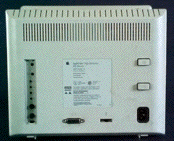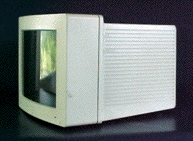Fact
Controlled
MATH
for
Special Learners
View from the
Classroom
Great Classroom Computer
Buys
on a Coke and Lunch Money Budget -- 68K
Macs
by
Steve
Wood
June
25, 2001
While newspapers and web sites often feature stories about schools and classrooms receiving thousands of new iBooks and/or iMacs, the reality for most of us is that we have to make do with what we've got. Funding for new computers has gotten incredibly tight after the first flush of e-rate funds to wire our nation's schools. Private schools are often in even worse shape. Buying Macs has become considerably more difficult due to the reluctance of schools to invest in Macs.
For a classroom teacher who could use more computers, there is some hope...if they are willing to invest some time and some semi-serious bucks and take matters into their own hands. Older Macintosh computers abound at various sales at bargain prices. As schools renovate computer labs, older machines are surplussed at auction. Online auctions also offer a variety of vintage but usable machines.
I also receive a good number of emails from folks who already are or wish to distribute older Macs to schools (not often well received), or other folks who can and will use them (often joyously received). I've written more than one unused column about such philanthropists, but frequently have difficulty checking the veracity of their claims and intentions, so the columns have died in production!
Over the last few years, I've had the opportunity to use a number of vintage Macs and have formed some clearly subjective opinions about what can be made serviceable in the classroom. I will confine my suggestions to my realm of experience, which may omit your favorite old Mac for the classroom, but I'd rather leave some out than recommend something that may not satisfy your needs.
Some decisions you'll need to make are whether you must have Power Macs or can rely on older 68K Macs. While many new titles require a Power Mac and a CD-ROM, many excellent older software applications run quite well on non-Power Macs (Mac II's, all of the 68K LC's, Centris, and Quadras). Also, a 68K with a network card can access files from a server . With a little coaxing, it may be able to use a CD or a self-mounting CD image stored on a server.
These suggestions are listed chronologically in order of their introduction dates. My thanks to Apple-History.com's Gallery listing from which I obtained this information. I have recently added a machine specific column index to my site to help folks find columns about particular Macs. This column does contain some references that are not included in that index. (There are actually a number of Macs I've used about which I still haven't posted a column. Stay tuned!) Low End Mac maintains an index page that includes links to their specific pages describing each of the machines discussed below.
The Mac SE series, including the Mac SE/30, are unparalleled for their charm. I've had kids absolutely fall in love with these machines. To that end I've written five different columns dealing with the SE family. I still have an SE/30 upstairs that I plan to get on the net. These are tough little machines that last a very long time.
Having said that, the SE series is really not worth the trouble they require to use from a technical point of view. The 8 MHz Mac SE typically comes with an 800K floppy drive and no hard drive. Some later models did have a 20 or 40 MB hard drive with a modern floppy, but they are in the minority. To do any serious upgrades, you must open up the box with a special torx screwdriver and venture very close to some high voltage components. Either way, unless someone gives you a bunch of them, it's probably best to avoid this series.
If you remain undaunted or happen to have a pile of these machines, see SE Saga, SE Saga part 2, SE Fever: The Lure (and Reward) of Vintage Computing, More SE Fever, or Adoption Notice for an SE/30 to see exactly what you can do with these machines.
The Mac II series represents the glory days of the Macintosh. Some of the finest and most expensive Macs ever produced were part of this series. While I've worked with an original Mac II and a Mac IIx, the specific RAM needed to upgrade beyond 8 MB is rare and the 16 MHz speed of the machines really doesn't encourage one to pursue upgrading them. Do note, however, that a IIfx motherboard will fit quite nicely, thank you, in a Mac II or IIx case.
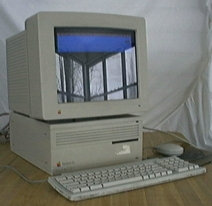 The
Mac IIcx was the first of a whole slew of Macs,
including the Quadra 700, to use the same form factor case.
I set up a Mac
IIcx for my teaching assistant and her children to use
at home. For simple word processing tasks and games, the
IIcx offers a more compact option to the Mac II or IIx.
It still employs a 16 MHz chip, but uses standard 30-pin
SIMMs. It does not have onboard video, so you'll need a
NuBus video card for one. They're cheap, as are NuBus
Ethernet cards, if you want to connect to a network. I'd put
a $5 price cap on any cards that you buy, but IIcx's often
are sold (or given away) with both already installed.
Actually, $5 ought to be a maximum price for a IIcx with the
cards already installed. The exception would be one with 64
or 128 MB of RAM. While I still have a couple of IIcx's
upstairs in various stages of parts extraction, I'd look a
bit upscale for a classroom Mac, again, unless someone gives
one to you.
The
Mac IIcx was the first of a whole slew of Macs,
including the Quadra 700, to use the same form factor case.
I set up a Mac
IIcx for my teaching assistant and her children to use
at home. For simple word processing tasks and games, the
IIcx offers a more compact option to the Mac II or IIx.
It still employs a 16 MHz chip, but uses standard 30-pin
SIMMs. It does not have onboard video, so you'll need a
NuBus video card for one. They're cheap, as are NuBus
Ethernet cards, if you want to connect to a network. I'd put
a $5 price cap on any cards that you buy, but IIcx's often
are sold (or given away) with both already installed.
Actually, $5 ought to be a maximum price for a IIcx with the
cards already installed. The exception would be one with 64
or 128 MB of RAM. While I still have a couple of IIcx's
upstairs in various stages of parts extraction, I'd look a
bit upscale for a classroom Mac, again, unless someone gives
one to you.
The Mac IIci was and is the school and business workhorse of the Mac II line. When introduced, it commanded about $8,000 for its new features, including onboard video support, 32-bit clean ROM, and the first appearance of the PDS slot, which allows all sorts of processor upgrades, including a cache card upgrade that gives the 25 MHz chip a real speed kick. (Yeah, I know. I'm gushing, but I really like this Mac model!)
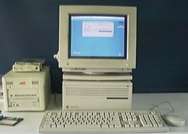 I
got my feet wet with the IIci series when one of my wife's
coworkers was given one and asked for upgrade advice.
Older
Macs describes that experience. One of the questions
asked by the coworker was about RAM upgrades, as she
couldn't open any other apps while working in Adobe
Illustrator! At that time, the coworker used a 200 MHz
Performa 5400 at work and wasn't phased by the speed
difference of the IIci. She was and is a truly charming and
patient person.
I
got my feet wet with the IIci series when one of my wife's
coworkers was given one and asked for upgrade advice.
Older
Macs describes that experience. One of the questions
asked by the coworker was about RAM upgrades, as she
couldn't open any other apps while working in Adobe
Illustrator! At that time, the coworker used a 200 MHz
Performa 5400 at work and wasn't phased by the speed
difference of the IIci. She was and is a truly charming and
patient person.
Apple must have sold a zillion IIci's, because they are all over the place in used sales. Because I get so many questions about this now eleven year old model, I wrote Illustrated Mac IIci Teardown last summer, which remains one of my all-time most read columns! If you like to tinker around a bit, this model is an easy one on which to start. It's almost the slowest Mac that I'd recommend putting any money into, and I'd advise caution at that. The IIci can still perform many useful tasks and can be easily but often not cheaply upgraded -- even to a Power Mac. It still is an old machine that may be prone to failure. It can't run Power Mac programs, and it lacks an internal CD. But...I do really like this one. Even so, $5-10 would be my highest offer for a IIci unless it already had a ton of RAM, a Daystar PowerPC card, a cache card, or some other inducement to make me spend something beyond lunch money on it.
 If
you thought I was gushing about the IIci, I'll probably
sicken you when I talk about the Mac IIfx. If
you made a list of the best 5 or 10 Macs ever, the IIfx must
be high on that list. Often a contrary monster, the IIfx ran
at 40 MHz in a time when 20-25 MHz was considered fast.
Where other machines used the main processor for many
functions, the IIfx had separate chip/controllers for some
non-processing functions. All of that commanded a price, and
Apple extracted in the neighborhood of $10,000 per machine
at its introduction. But then, at that time, there was
nothing else close to it for serious graphics work. My first
IIfx even came with a NuBus video capture card!
If
you thought I was gushing about the IIci, I'll probably
sicken you when I talk about the Mac IIfx. If
you made a list of the best 5 or 10 Macs ever, the IIfx must
be high on that list. Often a contrary monster, the IIfx ran
at 40 MHz in a time when 20-25 MHz was considered fast.
Where other machines used the main processor for many
functions, the IIfx had separate chip/controllers for some
non-processing functions. All of that commanded a price, and
Apple extracted in the neighborhood of $10,000 per machine
at its introduction. But then, at that time, there was
nothing else close to it for serious graphics work. My first
IIfx even came with a NuBus video capture card!
 I
currently use my best equipped Mac
IIfx as one of my classroom Macs. It has 80 MB of RAM, a
Radius video card that allows use of a 17" multisync
monitor, a good Ethernet card, a JackHammer SCSI card that
controls an internal 4.5 gig fast and wide drive, and a
slow, external CD-ROM drive. The machine is incredibly
quick, truly earning its ungrammatical "wicked fast"
description by Apple.
I
currently use my best equipped Mac
IIfx as one of my classroom Macs. It has 80 MB of RAM, a
Radius video card that allows use of a 17" multisync
monitor, a good Ethernet card, a JackHammer SCSI card that
controls an internal 4.5 gig fast and wide drive, and a
slow, external CD-ROM drive. The machine is incredibly
quick, truly earning its ungrammatical "wicked fast"
description by Apple.
Just plain wicked might be a more apt description, though, until you really get this model's idiosyncrasies solved. I cannot recommend this model for any take-home program or even for classroom use. It requires 64-pin SIMMs which remain quite expensive today, new or used. External SCSI devices must be terminated with a special black terminator that is no longer available new. I have two such terminators and am unwilling to part with either. Of course, I current own three Mac IIfx's, which leaves me one terminator short. Some might allege that owning any fx's indicates some serious mental shortcomings:-). Internal SCSI on some IIfx models requires a special internal SCSI filter (See Olde Mac Milt on eBay for one of these if you must.) Troubleshooting my Mac IIfx is the incomplete story of some of my classroom travail in trying to make one of these monsters work. However, once that magic was accomplished, what a performer!
 I
paid, gulp, $168.50 for my first IIfx! It was loaded, but
that was a ton to pay, even at that time. The last one
(pictured at right) came with video and Ethernet cards, a
keyboard, mouse, and a monitor included and ran $32 plus
shipping. It now functions as a server at home when I'm
setting up take-home Macs for my students. One nice thing
about many of the Mac II's is that with three to six NuBus
slots and cheap video cards, you can drive multiple
monitors. The IIfx price spiral hasn't stopped, so unless
the "IIfx (Apple) of your eye" has something compelling to
make you spend more, I'd put a $15 cap on expenditures for
just the CPU, RAM, and cards. Do note that 64-pin
SIMMS command a premium price.
I
paid, gulp, $168.50 for my first IIfx! It was loaded, but
that was a ton to pay, even at that time. The last one
(pictured at right) came with video and Ethernet cards, a
keyboard, mouse, and a monitor included and ran $32 plus
shipping. It now functions as a server at home when I'm
setting up take-home Macs for my students. One nice thing
about many of the Mac II's is that with three to six NuBus
slots and cheap video cards, you can drive multiple
monitors. The IIfx price spiral hasn't stopped, so unless
the "IIfx (Apple) of your eye" has something compelling to
make you spend more, I'd put a $15 cap on expenditures for
just the CPU, RAM, and cards. Do note that 64-pin
SIMMS command a premium price.
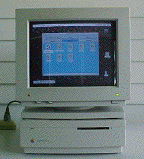 The
Mac IIsi was an economy ($3,800) Mac II that lacked
NuBus slots but did have a PDS slot. At 20 MHz, it won't
blow anyone away, but it can have an FPU upgrade that gives
it a bit more spunk.
The
Mac IIsi was an economy ($3,800) Mac II that lacked
NuBus slots but did have a PDS slot. At 20 MHz, it won't
blow anyone away, but it can have an FPU upgrade that gives
it a bit more spunk.  I
still have a IIsi that served as a backup machine in my
classroom several years ago. It had the advantage of a low
form factor that allowed me to stick it in an open front
desk when not in use. Mine currently sports a 250 MB hard
drive, 17 MB RAM, and Ethernet, cache, and FPU upgrades that
all fit into a PDS slot adapter. The IIsi does have onboard
video and used parts for the model seem plentiful. At the
right price (free), this model isn't a bad classroom
performer if you don't need a Power Mac or an internal
CD-ROM. I'd certainly not spend more than $5 for a base
model.
I
still have a IIsi that served as a backup machine in my
classroom several years ago. It had the advantage of a low
form factor that allowed me to stick it in an open front
desk when not in use. Mine currently sports a 250 MB hard
drive, 17 MB RAM, and Ethernet, cache, and FPU upgrades that
all fit into a PDS slot adapter. The IIsi does have onboard
video and used parts for the model seem plentiful. At the
right price (free), this model isn't a bad classroom
performer if you don't need a Power Mac or an internal
CD-ROM. I'd certainly not spend more than $5 for a base
model.
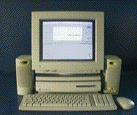 While
this is a totally subjective column, based upon my
experiences and whims, be forewarned that any incidental
objectivity still present flies right out the window when I
speak of the Mac LC III. My first classroom Macintosh
was an LC III, which would still be running today if it
hadn't become a serious organ donor last spring. I've put
almost 20 of this model into student homes without one
coming back as unrepairable. While I sweated bullets getting
the machines ready, the only hardware failures to date have
been one floppy drive that just died according to the
student's mother, but had a glue-like substance on the
floppy disk stuck in the ill fated drive, and a mouse that a
puppy thought was a chewy toy.
While
this is a totally subjective column, based upon my
experiences and whims, be forewarned that any incidental
objectivity still present flies right out the window when I
speak of the Mac LC III. My first classroom Macintosh
was an LC III, which would still be running today if it
hadn't become a serious organ donor last spring. I've put
almost 20 of this model into student homes without one
coming back as unrepairable. While I sweated bullets getting
the machines ready, the only hardware failures to date have
been one floppy drive that just died according to the
student's mother, but had a glue-like substance on the
floppy disk stuck in the ill fated drive, and a mouse that a
puppy thought was a chewy toy.
The LC III runs on a 25 MHz 68030 chip that does not have an FPU. It can handle a 32 MB 72-pin SIMM for a total of 36 MB of RAM. The onboard video will drive a 17" display in thousands of colors. It has a PDS slot that can handle an Ethernet card despite the low profile pizza box form factor. I found that you can perform a total teardown, including removal of the motherboard, of this model without any tools! You do need a screwdriver to remove the hard drive or floppy drive from their mounting brackets.
LC III's are regularly offered for under $10 each on eBay, but often have only the 4 MB of RAM soldered on the motherboard and a small, 80 MB hard drive. For comparison, the last one I purchased at a school surplus auction had 36 MB RAM, a 2 gig drive, besides a good 14" monitor, keyboard and mouse for $5. Don't get ripped off. While my deal was incredible, avoid folks selling stripped down LC III's on eBay for around $10-20, plus another $10 for shipping. If you can locate a school or university surplus sale, you can have the whole ball of wax for a pittance. If the price is right, this model could help you add a quantity of computers to your classroom for a minimal expenditure.
I've written three different columns that deal with the LC III, sometimes in unusual situations:
- Other than the stabbing... (10/23/1998)
- A Gaggle of LC III's: Part 1 (11/20/2000)
- A Gaggle of LC III's: Part 2 (12/21/2000)
The Centris/Quadra 610 is the only model of the Centris/Quadra line that I've been able to buy. Upscale Quadras seem to still command a price today beyond the budget buyer -- possibly pronounced penniless public pedagogue. (Can you tell I've been messing around with my thesaurus again?) The 610 is a wide, low-profile box that has a bay and cabling for a CD-ROM drive. It has Apple's sort of onboard Ethernet which requires an expensive add-on transceiver.
 The
25 MHz Quadra 610 can have heat dissipation problems, so
it's important to keep the fan and vents clean. It does not
come stock with an integrated FPU, but you can easily swap a
full 40 chip into it. The Centris 610 is essentially the
same machine, but runs at only 20 MHz.
The
25 MHz Quadra 610 can have heat dissipation problems, so
it's important to keep the fan and vents clean. It does not
come stock with an integrated FPU, but you can easily swap a
full 40 chip into it. The Centris 610 is essentially the
same machine, but runs at only 20 MHz.
I put one Quadra 610 out to a student as a take-home model, as I had an extra 2X CD-ROM and sled for it, and it has worked well for him. I have another that I will probably use in a similar fashion next year. One other note of caution in buying this model is to check to make sure the "feet" are undamaged. They break off easily and replacements are rare and consequently priced as such. I'd only recommend the Quadra 610 as a $20 max purchase if it has a CD and an extra stick or two of RAM in it.
 The
Performa/LC 550 is basically an LC III motherboard in
an all-in-one configuration. You already know of my affinity
for the LC III -- at the right price -- so it shouldn't come
as a surprise that I just bought 4 Performa 550's at
A
Surplus Auction to use as take-home units for any new
full or part-time students added to my special education
classroom next year.
The
Performa/LC 550 is basically an LC III motherboard in
an all-in-one configuration. You already know of my affinity
for the LC III -- at the right price -- so it shouldn't come
as a surprise that I just bought 4 Performa 550's at
A
Surplus Auction to use as take-home units for any new
full or part-time students added to my special education
classroom next year.
 At
the right price, the 550 has the advantages of an integrated
14" Trinitron display, an open bay for a CD-ROM drive
(you'll need a different front bezel [cover],
though), and can be upgraded to a 570 series with a
Performa/LC 575 motherboard with its 33 MHz 68LC040 chip. It
also has the disadvantage of having an integrated 14"
Trinitron display. If the monitor goes out, ouch! The last
replacement CRT I bought ran around $50. Also, I should add
that the power supply on these models is integrated on the
video analog board. If it fails, ouch again. I paid 10 bucks
each for my 550's, so I'll take the risk. I let bids pass at
$15 and $12.50 each, but $15-25 for one of these gems that
includes a keyboard and mouse would be a great deal.
Unfortunately, that's beyond my lunch money budget:-).
At
the right price, the 550 has the advantages of an integrated
14" Trinitron display, an open bay for a CD-ROM drive
(you'll need a different front bezel [cover],
though), and can be upgraded to a 570 series with a
Performa/LC 575 motherboard with its 33 MHz 68LC040 chip. It
also has the disadvantage of having an integrated 14"
Trinitron display. If the monitor goes out, ouch! The last
replacement CRT I bought ran around $50. Also, I should add
that the power supply on these models is integrated on the
video analog board. If it fails, ouch again. I paid 10 bucks
each for my 550's, so I'll take the risk. I let bids pass at
$15 and $12.50 each, but $15-25 for one of these gems that
includes a keyboard and mouse would be a great deal.
Unfortunately, that's beyond my lunch money budget:-).
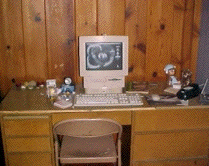 My
first Mac at home was a Performa 575 purchased in
1994. Our youngest, Julia, still uses it daily, although
grudgingly. She's pushing for an iMac. But then, we gave my
oldest son an iMac for a wedding present and got another of
our daughters an iMac as a high school graduation present.
Considering our family finances and the quantity of 500
series parts I have on hand, I suspect it will be graduation
or marriage before Julia sees a new computer!
My
first Mac at home was a Performa 575 purchased in
1994. Our youngest, Julia, still uses it daily, although
grudgingly. She's pushing for an iMac. But then, we gave my
oldest son an iMac for a wedding present and got another of
our daughters an iMac as a high school graduation present.
Considering our family finances and the quantity of 500
series parts I have on hand, I suspect it will be graduation
or marriage before Julia sees a new computer!
The Performa/LC 575 series can be an exceptional buy at the right price if it fits your needs. The 14" display is a tad small by today's standards, but has a very sharp picture when properly adjusted. While still not a Power Mac, the 575's 68LC040 chip will perform word processing quite well. Either AppleWorks/ClarisWorks or Microsoft Word 5.1 will do all the word processing you'll ever want on it. Surfing the web at 33 MHz isn't much fun, but it can be done.
The 575 motherboard has a PDS slot and a COMM slot, which can be used for upgrades and a modem or Ethernet card. Our 575 at home sports a Daystar Powercard 601 upgrade that makes it a Power Mac, albeit a 66 MHz Power Mac. Another 575 I use at school has a full 68040 chip in it. That upgrade, a simple chip swap, added a FPU unit that considerably speeds the unit. It also allowed a 64 MB RAM chip to function in its single 72-pin SIMM slot.
While the Performa 575 always came with an integrated CD-ROM, the LC 575 version came either with or without the drive. Without, it's not a real bargain, unless you have the drives, sleds, and bezels on hand to do an upgrade. I had a deal lined up last winter for 14 LC 575's with CD-ROMs, keyboards, mice, and extra batteries for $25 per machine! Bad weather and procrastination prevented closing the deal and the seller sold off all of his 68K machines to another vendor. The new vendor was supposed to contact me, but never did. I don't blame him, as he probably can sell the machines for far more individually. While I'd still pay $25 each for the group of 575's, a more realistic price of under $50 is still fair.
Two important cautions apply to buying a 575 (or 577 or 578 -- same machine, just different size hard drives). The 575 uses a 4.5 volt alkaline battery that when dead, can make the whole machine appear dead. These batteries are more expensive than the usual Mac 3.6 volt lithium battery. They run about $15 each, which can undo your classroom upgrade budget pretty quickly.

 The
second caution is that these machines do not ship well! They
are rather heavy and I've read several stories
about them coming apart during shipment, even with the best
of packing. I, too, had the misfortune of buying one from an
eBay vendor and having it arrive ruined. I don't know if the
seller was an idiot, whose idea of careful packing was just
throwing packing peanuts around the machine, or a crafty
crook, who may have shipped an already broken machine
purposely poorly packed. I thought I was just out the
shipping charge and filed for the postal insurance, but the
vendor apparently never completed and returned his part of
the paperwork to the Post Office. I never got a cent
back.
The
second caution is that these machines do not ship well! They
are rather heavy and I've read several stories
about them coming apart during shipment, even with the best
of packing. I, too, had the misfortune of buying one from an
eBay vendor and having it arrive ruined. I don't know if the
seller was an idiot, whose idea of careful packing was just
throwing packing peanuts around the machine, or a crafty
crook, who may have shipped an already broken machine
purposely poorly packed. I thought I was just out the
shipping charge and filed for the postal insurance, but the
vendor apparently never completed and returned his part of
the paperwork to the Post Office. I never got a cent
back.
The LC 580 is not quite the same machine as the 550 or 575. While it shares the same enclosure, the 580 uses an internal IDE hard drive and uses an inferior CRT to the excellent Sony Trinitron monitor of the other 500 series machines. It's motherboard does have two RAM slots, allowing up to 52 MB of RAM. It will accommodate a full 40 chip or a Daystar Powercard upgrade. The 580 typically came with a larger hard drive (500-800 MB) than either the 550 or 575 (160-320 MB). Of course, you can upgrade the hard drives, but that again can punch a big hole in your computer budget very quickly. If you get a shot at one of these for a good price, probably no more than $30 due to the cheap display, grab it! The LC 580 winds up the 68K Macs. It was actually introduced after the first of the Power Macs!
If you can, always try to get a keyboard and a good mouse with any CPU you purchase (for no extra money, of course). The second round of LC III's I purchased for take-home student units came without keyboards, mice, hard drives, and hard drive brackets. It was one of the worst deals I've ever made, as I took a beating finding those items by themselves.
What about monitors?
Color displays can be had at times just as cheaply as CPU's. At other times, there doesn't seem to be a good deal anywhere in the country. With the computers I put in students' homes over the last year, the monitor often cost me three times as much as the CPU! Part of the problem is that all displays are rather heavy and therefore expensive to ship. If you can buy a display locally, you'll really stretch your lunch money dollar. Always keep an eye out for a good color display at a good price.
|
My pick for most of the LC III's I put into homes last year was the 14" Macintosh Color Display. This 22-pound unit has a sharp Trinitron CRT and is fairly rugged. It has a swivel base and an integrated monitor cord. Brightness and contrast controls are on the front of the unit. Ten dollars plus shipping is a fair price for these, but you'll have a tough time finding that price. |
|
|
|
|
The AppleColor High-Resolution RGB Monitor is an old 13" display that weighs well over 30 pounds. Apple stopped selling this unit in 1992, so you know they are durable. Some models in this line had full video adjustments available on the rear panel, allowing one to stretch the screen to the equivalent of a 14" display. Don't pay over $5 for one. |
|
With any of the displays mentioned, it is far better to buy locally where you can turn the thing on and see just how bright the picture is. Most displays that fail simply have a worn out CRT (picture tube). The display becomes so dim that using it is difficult. On these older models, replacing a CRT is cost prohibitive, as you can usually buy 2 or 3 more used complete displays for the cost of a CRT replacement (parts only). When you shop locally, insist on plugging in the display and turning the brightness up all the way to see if it has enough pizzazz to serve your needs. (The catch here is that you need to have the display hooked up to a computer that is on as well.) If the display is very dim or has gray horizontal lines showing when the brightness is turned up all the way, you don't want the unit. That's a precursor to CRT failure (often seen in the SE series).
PC monitors can serve nicely with the proper adapter. Again, the adapter adds to your expense, so consider that in any purchase. Where I would consider a PC monitor with an adapter is for a larger display. If someone wants to practically give away their 15-17" PC monitor, it might be worth the gamble that you can make it work with one of your Macs.
Then what about the 68K Macs I haven't mentioned?
If you run into a deal on an LC or LC II, step over or around it -- just don't step in it. Dogs by design, these machines' greatest contribution was paving the way for the LC III. Old PowerBooks drain batteries and pocketbooks equally quickly. Avoid them unless you have excellent technical skills with laptops and a high tolerance for frustration. I have no experience with Mac Classics or the later Color Classic, other than losing bids to folks who wish to upgrade a Color Classic to a G3!
 Having
read my recommendations, you can tell that I'm normally a
rather stingy buyer with a few wildly extravagant exceptions
(fx, fx, fx). If you have deep pockets, you can head for
eBay right now and spend a lot and possibly be sorry later!
Then again, I spent a ton for my first Mac IIfx and I still
love it.
Having
read my recommendations, you can tell that I'm normally a
rather stingy buyer with a few wildly extravagant exceptions
(fx, fx, fx). If you have deep pockets, you can head for
eBay right now and spend a lot and possibly be sorry later!
Then again, I spent a ton for my first Mac IIfx and I still
love it.
Try not to fixated (or is that "fx-ated") on just one model. The 68K Mac lineup is a fantastic smorgasbord for budget minded vintage Mac shoppers. Some of my favorite Macs are machines I thought I really didn't want. Within the machines I've suggested, the trick is to get the best working model you can for your limited dollars.
Remember that folks are selling used 68K Macs every day of the week. If you miss a deal today, like those 575's I missed last winter (grrr), someone else, somewhere else, will have a deal for you tomorrow or next week. Besides, just how many Macs can you, or possibly more significantly, your significant other, tolerate sitting around until you get them ready for your classroom or giveaway project?
Next Week
In a week or so, I'll tackle the Power Mac field. By definition, you might exclude any Power Mac from a budget buying discussion, as they consistently run a good deal more than their now ancient 68K forerunners. I certainly do.
But who could resist the opportunity to take another cheap shot at the all-time worst Mac ever produced? Tune in to find out the identity of this disaster and a few that could make a pretty good buy for those on something more than a coke and lunch money computer buying budget.
Send your feedback to
Steve
Wood
©2001 Steven L. Wood


